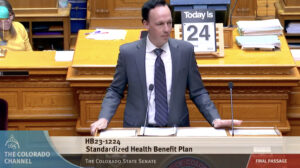As the Colorado Option insurance program moves into its second year, analysts parse numbers to evaluate its success. No, most plans won’t hit 10% premium-reduction goals outlined in law. But, yes, residents in every county in 2024 will have multiple plans from which they can choose.
Moving past this exercise of prioritizing metrics, however, observers of the first-in-the-nation policy more urgently are trying to determine the underlying effects that the mandated lower-cost insurance option is having on the state’s health-care costs and its care system. And this is where opinions diverge even more sharply.
Putting aside the specific numbers, Colorado Insurance Commissioner Michael Conway said the program is hitting its goal by beginning to bend the cost curve of what had been rapidly escalating premiums. While Colorado Option premiums are set to rise by as much as 7.7% in 2024 — a total expected to be lower when Conway approves final rates in October — that is less than the 11.1% average hike in non-option premiums and below the hikes of previous years.
“This is a work in progress,” said Sen. Dylan Roberts, the Avon Democrat who co-sponsored the bill launching the program, as well as a measure this year that made some fixes to the law. “I think that people have been too quick to judge the Colorado Option just off of one year of data. We wrote the Colorado Option with the intention of having a three-year rollout, and we’re not even halfway through the rollout at this point.”

Colorado state Sen. Dylan Roberts speaks on the Senate floor in April about his bill to make changes to the Colorado Option insurance program.
“Flawed policy”
But Sen. Jim Smallwood, a Douglas County Republican who operates an employee-benefit insurance brokerage, not only asserts that the program is falling short of its own goals but that it’s imposing unsustainable insurance rates that make it difficult for insurers to operate here. Three insurers have left the state since 2022 — including Friday Health Plans, whose implosion was due in part to lacking the revenue to match its business model — yet insurance regulators continue to try to force down rates in a way that makes a greater exodus likely, he said.
“At its foundational heart, this is why it’s a flawed policy: It’s forcing carriers and providers to have rates that aren’t market-based rates,” added Tom Rennell, senior vice president of financial policy and data analytics for the Colorado Hospital Association, whose members had to cut some reimbursement rates because of the program. “It’s rate mandates. It’s rate controls. This has proven never to work in any industry in the history of U.S. policy.”
Legislators proposed the Colorado Option because state-regulated insurance rates — those for policies purchased by small businesses or individuals — were becoming an increasing problem for residents and employers. Average premium costs for small businesses are up 43% over the past decade, National Federation of Independent Business state director Tony Gagliardi noted during a July hearing, and Small Business Majority state director Lindsey Vigoda said such costs are causing some entrepreneurs to close shop and get corporate jobs.

Lindsey Vigoda is Colorado director for the group Small Business Majority.
How the Colorado Option works
The Colorado Option requires insurers to offer plans with defined benefits, such as free preventative-health and behavioral-health services — at rates lower than they charged in 2021. Those rates were supposed to be down 5% this year, 10% for 2024 and 15% for 2025, though the state can’t force unsustainable rates or those that reduce hospital reimbursements to less than 165% of Medicare reimbursement rates (which cover about 80% of treatment costs).
Few plans other than those offered by Denver Health — which, as a system, has had to accept bailouts from the state and from Kaiser Permanente because of its financial losses — would reach the 10% reduction goal next year, according to initial submissions by insurers. Medical inflation and post-pandemic changes such as longer hospital stays due to sicker patients are the most cited reasons that insurers can’t demand lower reimbursements from providers and cut their own rates.
Conway has the power to step in and negotiate lower reimbursement rates for hospitals when data informs him that there is room to cut costs, and he took that step in a handful of instances this year. That in turn allows his division to negotiate lower rates with insurers, and Colorado Consumer Health Initiative Deputy Director Adam Fox has called for the state to approve rates lower than those submitted by insurers because of that.
“We do expect to see the preliminary Colorado Option rates in particular decrease,” Fox said in an interview. “Those increases — the 7.7% average across Colorado Option plans — should decrease significantly … DOI should ensure that.”
Success or failure?
Still, many plans won’t come close to hitting reduction goals. And this year’s shortfall means the 15% cut in rates mandated by 2025 will be very difficult to achieve, both proponents and opponents have said.

Colorado Insurance Commissioner Michael Conway
Conway and Roberts point to the Colorado Option capturing 13% of the individual market during its first year of operations to call it a success, noting a similar plan in Washington state garnered just 1% share. Roberts added that option plans are available in 2024 in every county, including some where residents had just one potential plan available before. And Conway said the presence of the Colorado Option plans cut premiums for the second-lowest-cost silver-level plans on the state health exchange by 4.7% this year.
“We know it’s succeeding, just because of what we’re seeing the first two years,” Conway said in an interview. “If (observers) were having an honest conversation about a product taking over a percentage of a market in one year, anybody would tell you that a product taking over 13% to 14% in one year is a success.”
But while more than 30,000 buyers on the individual market chose a Colorado Option plan, just 142 participants in the small-group market made the same choice, Vigoda said — a particularly eye-popping number because so many of the state’s businesses are small. And an actuarial analysis commissioned by pro-free-market group America’s Health Care Future Action found that option plans were the lowest-cost choices on the silver tier in just 10 of the state’s 64 counties this year and on the lower-benefit bronze tier in just four of the 64 counties.
Fears about growth of the plans
But even as skeptics argue that the program has been a failure because of its inability to take deeper root and offer lower prices, they warn that greater harm could come if the plan were to meet its premium-reduction goals and find a larger customer base. That’s because the fundamental economics of the plan are proving to be unsustainable, they said.
While Smallwood declined to attribute the decisions by Humana, Bright HealthCare and Friday to pull out of the state to the program — with Friday shutting down altogether and leaving 30,000 customers to find new insurance in mid-year, according to media outlets like the Colorado Sun— the Colorado Option has made the market a tougher place to operate. Insurers must meet arbitrary rate reductions that could boost losses with each new customer who buys the option plans, and that erosion of insurers (down to six in the small-group market) will boost rates further due to a lack of competition, he argued.

A hospital nurse prepares an infusion for a cancer patient.
Hospitals, meanwhile, have been forced to take lower reimbursements for option plans and offer different rates to insurers for option and non-option plans, Rennell said. Because such a small percentage of customers seeking care at facilities are on option plans now — individual-plan consumers are a much smaller part of the market than large-group customers — hospitals haven’t had to reduce services because of those lower reimbursements, but a significant boost in option-plan customers may change that, he said.
The role of hospitals
Consumer-advocacy organizations and leaders in Gov. Jared Polis’ administration have long said high hospital profit margins are a primary reason that residents pay so much for health care in this state, but Colorado hospital leaders call those stats outdated.
In July, the CHA noted that with supply expenses up nearly 40% since 2019 and overall expenses exceeding revenue by more than 10% in that time, operating margins decreased $300 million in the first quarter of this year. Roughly 60% of state hospitals are operating now on margins of 4% or less that are unsustainable, Rennell added.
“The picture’s changed a ton,” he said. “There’s been a really big shift in this state and across the country. The industry has shifted, and the margin is way lower.”
Insurers’ stability
Still, the state is pushing “unachievable cost requirements” for insurers that don’t factor in the increased utilization of health care that’s marked consumer behavior since the beginning of the pandemic, said Saskia Young, executive director of the Colorado Association of Health Plans. Thus, insurers are worried both that the state is trying to push down rates beyond a place where they will be sustainable and that the state is allowing companies like Friday to operate with rates that are too low.
Conway countered that Friday’s collapse was an internal issue that spread beyond Colorado to other states where it operated and that his division last year forced it to raise rates above what it proposed for 2023. He noted Wednesday that the federal government awarded DOI $245 million in pass-through funding for the savings achieved by the state’s lauded reinsurance program and the Colorado Option, though it didn’t break out how much each program saved.
Observers will continue to watch for the effect that the Colorado Option has on health-care providers, insurers and the businesses that are struggling to afford the cost of policies to cover their employees. And those on both side of the issue agree that the success or failure of the program may be determined most by whether there is an increased push for more government involvement in health insurance, such as any effort to create a Canada-style single-payer plan.
Two views on the Colorado Option

Sen. Jim Smallwood speaks during the 2023 legislative session on the Senate floor about the Colorado Option.
Conway, who expects the program to grow its participant base over the next year as more people learn about it, argued that he didn’t understand why so many of its opponents would seek to call it a failure. The Colorado Option remains a solution in which private insurers are offering products, and a true lack of success could increase calls to remove such companies altogether from the health-care sphere.
“If it doesn’t work, we have a very, very blue Legislature where I think some people will want to take this further and create something closer to a true public option,” he said. “Right now, I think there’s a market and an opening for everybody to say it’s working.”
Smallwood, however, believes that some backers would prefer to see more insurers leave the state under the argument that they can’t make money, feeling that would create the true outcome that they want. And the way the program is going, he thinks it’s leading to that end.
“If your goal is to get rid of the private insurance marketplace, this is not disingenuous at all,” he said. “I’m one who thinks we need a robust marketplace to attract businesses. And I’m one of those voices who thinks that is very important.”
